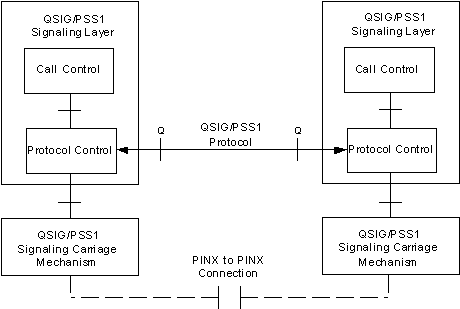
You are here: CSP Developerís Guide: Common Channel Signaling†>†12 QSIG/PSS1†>†QSIG/PSS1 Basic Call Signaling
QSIG/PSS1 Basic Call Signaling

Purpose
The CSP supports the QSIG/PSS1 global signaling and control standard for Private Integrated Network Exchange (PINX) applications, intended for use in private corporate ISDN networks. QSIG is a Euro-ISDN based protocol for digital Common Channel Signaling (CCS) and is used to build private networks using Virtual Private Networks (VPNs) or leased lines.
Q Signaling (QSIG), an ISDN based protocol, enables signaling between different voice communications platforms and equipment (nodes) in a multi-user environment. It is often referred to as an inter-PBX signaling system. It can also be deployed in a single-user environment.
Internationally, QSIG is also known as Private Signaling System No. 1 (PSS1).
The QSIG/PSS1 Basic Call Signaling provides signaling for establishing, maintaining and clearing a circuit-mode basic call at an interface between multiple PINXs. Layer 3 of QSIG, called QSIG Basic Call (BC), is a protocol that is symmetrical in nature. This means that interfaces from the network side and the user side are identical, so basic communication between multi-user nodes is transparent. Signaling between two PINX locations occurs when a call is set up and maintained in a multi-user environment. For example, if a caller from PINX A wants to make a call to a user in PINX B, QSIG BC ensures that certain mandatory features (such as call setup) are carried from one node to another.
The QSIG/PSS1 Basic Call Signaling is only supported on the ISDN Series 3 card. There is a limit of 32 D channels per ISDN Series 3 card and a system (node) limit of 64 D channels. This allows for a maximum of two ISDN Series 3 cards per chassis.
Important! On a single ISDN Series 3 card there is a pool of 32 D channels that can be configured for QSIG, V5, or ISDN applications in any combination as long as the 32 channel limit is not exceeded.
The ISDN Configuration (CFG) task implemented on the ISDN Series 3 card supports the configuration for the QSIG variant. The ISDN Interface Configure (0x0060) API message also supports the configuration for the QSIG variant.
The ISDN IPRI task supports implementation of QSIG specific call control procedures. Segment messages are routed to the L3 Call Reference (0x08) component to the L3P Call Control (0x05) component and to the L4 Call Control Management (0x61) component. The segment message is sent to L4 Call Control Management (0x61) component in the M_MSG format, where it is then converted to Universal Protocol message format.
The L4 Call Control Management (0x61) component also supports the L4 CH SEGMENT PPL Event Indication/Request API messages.
In the figure below, the Protocol Control is implemented on the ISDN Series 3 card. The Call Control functionality will be implemented on the application running on the Matrix Host. In this way, depending on application running on the host, the switch can act as a Transit PINX, an Originating PINX, a Terminating PINX, an Incoming Gateway PINX, or an Outgoing Gateway PINX.
The signaling messages used to establish, maintain, and clear a circuit-mode Basic Call at an interface between the two PINXs are exchanged over a Signaling Carriage Mechanism (SCM) connection within the signaling channel of the Inter-PINX link.
Figure 12-1 QSIG/PSS1 Control Protocol Model

Message Segmentation and Reassembly
Message Segmentation and Reassembly procedures are required to support QSIG ISDN messaging. For detailed information, refer to the QSIG/PSS1 Message Segmentation and Reassembly section.
QSIG is a licensed feature based on chassis ID. For detailed information, refer to the QSIG/PSS1 Licensing section.
QSIG - Q interface Signalling protocol
PSS1 - Private Network Signalling System No. 1
PISN - Private ISDN
DSS1 - Digital Subscriber Signalling No. 1
ETSI - European Telecommunications Standards Institute
ISDN - Integrated Services Digital Network
ITU-T - International Telecommunication Union
PBX - Private Branch Exchange
PINX - Private ISDN Exchange
UPD - Universal protocol data format: A set of predefined data formats used by line card to communicate to L4 and above.
QSIG BC is required of all users that claim QSIG compliance.
QSIG Generic Function (GF) Protocol
QSIG Generic Function (GF) protocol is not supported for this release.